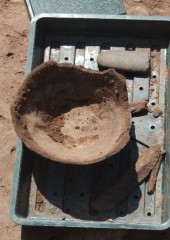For many students currently taking degrees, the year 1963 probably sounds like prehistory! However, it was this year that the recently popular and newly 'cool' series 'Doctor Who' began. Admittedly, back then it had a grandfatherly Doctor, a teenager and two older companions, the budget was tiny and the sets and monsters sometimes wobbled. But there must have been something about the programme that kept it on air for twenty six years, spawned an American co-produced TV movie in the 90's and caused a BBC reboot of the series in 2005.
Returning to the winter weekends of 1963, the Doctor's first TV adventure, 'An Unearthly Child', saw him on a then present-day Earth and his grand-daughter at a London school, where two teachers became suspicious about her strange knowledge and the basic gaps in it. They followed her home, pushing their way into a Police Box in a junkyard where they thought she was being held prisoner. They stumbled into the TARDIS... (Doctor Who, 1963).
Fearing that the teachers, Ian and Barbara, would talk about what they had seen if he let them go, the Doctor set his craft in motion, kidnapping the teachers and plunging them all back to the 'stone age' (Doctor Who, 1963).
What developed then was a basic capture and escape story. The time travellers find themselves in a prehistoric landscape, where the Doctor is quickly taken hostage. He had been in the process of lighting a pipe when a watching native took him by surprise and forced him back to his camp (Doctor Who, 1963).
This, to the archaeologist or archaeology student, is a world of Mesolithic hunter-gatherers. The local tribe worship Orb (the sun) who has deserted them in recent months (probably due to a volcanic ash cloud acting as a barrier) and they fear the return of the Great Cold (the last Ice Age perhaps, still fresh in the tribal memory). Food is scarce, likely due to the lack of sunlight, and the tribe is barely surviving (Doctor Who, 1963).
The tribal leader has died suddenly, taking with him the secret of making fire which his son, Za, was not taught before inheriting the role. Kal, who has recently joined the tribe claiming to be the sole survivor of his own people, has captured the Doctor. He wants to lead the tribe and challenges Za, claiming the Doctor and his friends will make fire for him (Doctor Who, 1963).
Despite this being the early 1960's, there are a number of archaeological elements in the story that we would recognise today. The battle between Za and Kal is a basic struggle for power and status within the tribe. As well as worshipping Orb, these people also venerate the ancestors, as the time travellers are imprisoned within the Cave of Skulls, a repository for the bones of the dead. This is sealed by a large boulder, but there is another way in and out, known only it would appear to the most elderly member of the tribe, a woman (Doctor Who, 1963).
Gender archaeology is also catered for, as the two tribal women (the old woman just mentioned and Za's mate), rather than being weak females are shown as having strong influences upon the men around them, as well as having their own agendas. At one point, the old woman helps the travellers escape, because she does not want things within the tribe to change. Za's mate meanwhile has a persuasive effect upon the young tribal leader, instructing him subtly in how to be a stronger leader and frustrate the plans of Kal (Doctor Who, 1963).
Props are also well made and impressive looking. The stone axes seen on screen are familiar to anybody who has studied such artefacts, while the flint knife brandished by Kal in the final episode is also a faithful recreation of a stone tool. Good to see that such attention to detail was being put into what was essentially a children's programme at the time it was made.
The actors took their roles seriously, throwing themselves into the parts as if this were a play aimed at adult audiences. These are not performances that are 'dumbed down' or in any way aimed at a younger audience. They are played straight, real and to a very competent script.
Eventually, the travellers make fire for Za, who then defeats Kal in battle. Rather than releasing them as promised, Za wishes to keep them around to advise him, but the Doctor and his friends have other ideas, tricking the tribe and escaping, though their next journey is to face the Daleks for the first time (Doctor Who, 1963). Talk about jumping out of the frying pan into the fire!
In conclusion, for a kids television programme made on a tight budget in the 1960's, a lot of thought and care went into the production of the first ever Doctor Who story. It is not perfect, for even though the 'caveman' section takes up just three episodes of four it feels long, with a repeated capture and escape sequence. But the script, acting and props made not only an interesting story for a general audience, but also a fascinating one for anybody with an interest in archaeology and especially prehistory. Well worth seeking out for anybody that has yet to watch this early television classic.
Bibliography
- Doctor Who.(1963) BBC1 television broadcast, 23rd November - 14th December 1963.




